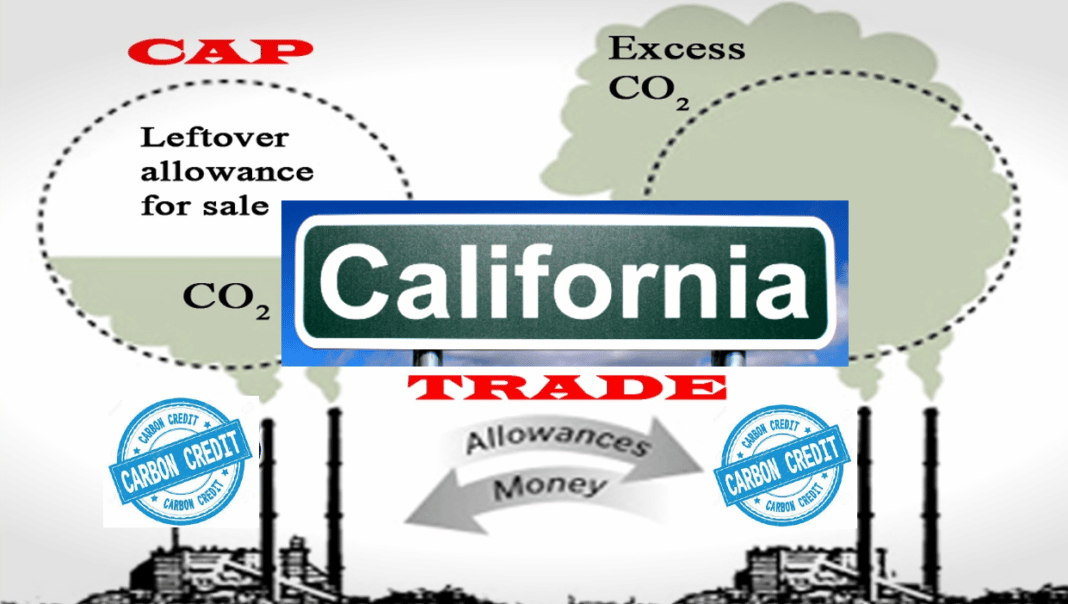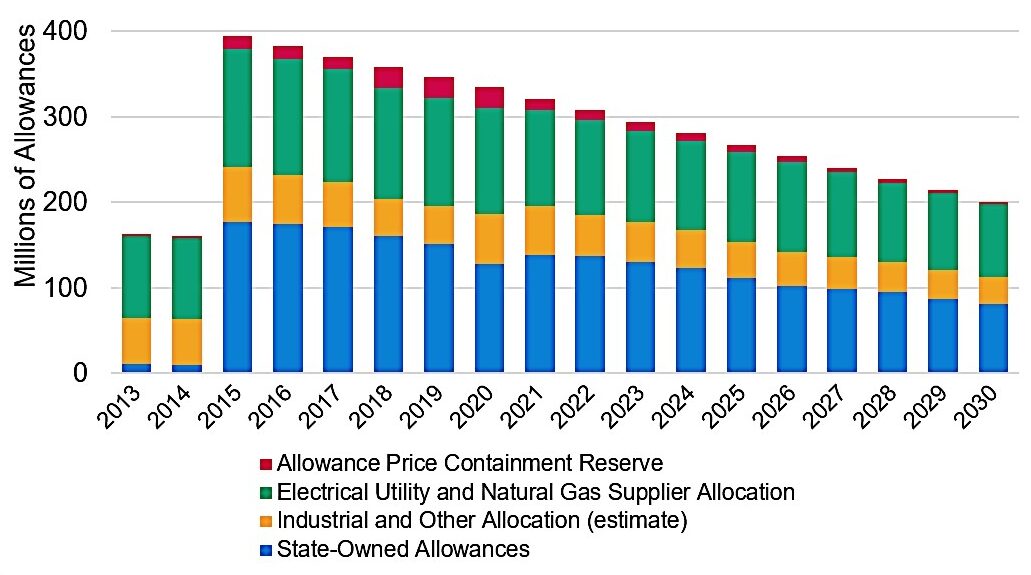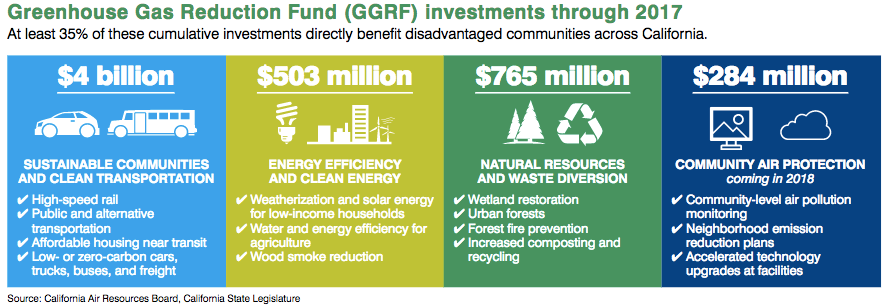Over a decade ago, an innovative carbon credits or emissions trading system (ETS) was established in California. It refers to the state’s “cap-and-trade” program that limits carbon emissions, creates a market for tradable emissions credits, and helps fund climate-related projects.
The program is a key element of California’s strategy to cut GHG emissions while complementing other efforts to ensure that the state meets its climate goals. Its history, operations, and ways of business can help similar programs elsewhere succeed.
So, how do California carbon credits work? What are the key components of the state’s carbon credit program? Or you may want to know more about how to sell, or perhaps how to buy California carbon credits. Either way, this guide article gives you the answers you’re looking for in clear, easy way.
Let’s start off by explaining how the California carbon credits program works.
How Do Carbon Credits Work in California?
The Cap-and-Trade Program, established in 2006, sets a declining limit on major sources of GHG emissions throughout California.
The basic concept is to create a market-based compliance approach to drive investments in climate strategies. It’s the only economy-wide carbon market in the U.S. and one of the largest ETS in the world. It supplements a range of various carbon reduction programs in the state.
The program is central to meeting California’s ambitious climate goals:
- To reduce emissions to 1990 levels by 2020 (which it met in 2016),
- 40 percent below 1990 levels by 2030, and
- 80 percent below 1990 levels by 2050.
The state also has additional goals of reaching 100% carbon-free electricity by 2045 and economy-wide carbon neutrality by the same period.
The California Air Resources Board (CARB) manages and oversees the program. The Climate Action Reserve (CAR) serves as the Offset Project Registry under the program. CAR can issue Registry Offset Credits (ROC) under CARB Compliance Offset Protocols.
Fast Fact: ROCS are not compliance instruments under California’s Cap-and-Trade program. They must first be transitioned into CARB offset credits to be eligible for compliance under the program.
- The California carbon credits program covers about 85% of the state’s GHG emissions. The number of entities that are subject to the cap is 450+. They have to be large enough, emitting at least 25,000 MT of CO2e each year.
CARB creates allowances, also called carbon credits, equal to the total amount of allowed emissions (the cap). One allowance or carbon credit equals one metric ton of CO2 or its equivalent emissions under the 100-year global warming potential (GWP).
Every year, fewer carbon credits are created and the annual cap declines over time. Allowances have an increasing annual auction reserve or floor price. This, plus the decreasing annual credits, make a steady carbon price signal to stir action to cut emissions.
All covered entities in the California carbon credits program are still subject to existing air quality permit limits for criteria and toxic air pollutants. Each of them has to surrender one carbon credit, which represents one permit to emit for each ton of carbon.
-
The majority of those permits will be allowances but entities can still use a limited number of CARB offset credits.
Some entities will have some mandated allowances. Yet, they can buy additional allowances at auctions, buy them from others, or buy offset credits through projects.
Fast Fact: Compliance offset projects must be listed with an approved Offset Project Registry like CAR to be eligible to earn CARB Offset Credits. CAR offers CARB-approved services like listing projects and issuing carbon offset credits.
State-run auctions occur on a quarterly basis. Entities under compliance can participate and buy the required number of carbon credits. They have to retire the credits on an annual basis against their cap levels.
To make things even clearer, let’s break down each of the basic components of the carbon credit market in California.
Key Components of Carbon Credits System in California
When talking about carbon credits in California, there are three major elements involved – allowances, offset credits, and compliance period.
What is an allowance?
An allowance is a tradable carbon credit serving as a permit to emit one metric ton of CO2e. Each allowance has a unique serial number. The total number of allowances that CARB provides each year is equal to the annual cap.
Carbon credits under the California ETS or cap-and-trade program are distributed under four broad categories:
- Cost-containment (red)
- Utility allocation (green)
- Industrial allocation (yellow)
- Auction (blue)
The chart below shows their distribution per category.
California ETS Allowances Distribution
Cost-containment reserves and a price ceiling reduce price volatility, if needed. While allocation to electric and natural gas utilities is for the benefit of end-users. Allowances for industrial facilities meant to minimize relocation of their emissions to areas without carbon pricing.
After satisfying the allocation to those three categories, the remaining state-owned carbon credits, in blue, are auctioned quarterly. Covered entities and voluntary market participants can buy the auctioned allowances.
The auction proceeds go to the Greenhouse Gas Reduction Fund (GGRF). As of June 2022, the GGRF is worth ~$20 billion in total capital for the state to use. The fund has supported 500+ million individual emissions reduction projects across California.
What is an offset credit?
An offset credit is equal to a GHG reduction or removal of one metric ton of CO2e. The reduction or removal credit must be real, additional, measurable, permanent, and verifiable.
- The carbon offset credits can only be issued to projects that comply with the Compliance Offset Protocols.
CARB offset credits differ from allowances, but they are often both referred to as compliance instruments. That’s understandable though as they’re both used by entities to comply with the California carbon credit program. But it’s important to take note of the difference between them.
CARB offset credits vs. allowances:
Carbon allowances don’t represent the reduction of any emissions but simply a permitted emission under a regulated scheme. They are issued by the state government who sets the overall number of allowances with an annual cap – permitted level of emission.
CARB offset credits, on the other hand, refer to the verified emissions reductions generated from a certain carbon offset project. A covered entity may only meet up to 8% of its compliance obligation using CARB offset credits.
So, in sum, carbon allowances are issued annually by the regulator while carbon offset credits undergo a rigorous approval and verification process before being issued.
Compliance period:
It refers to the time frame that an entity has to comply with the mandated emissions reductions. The compliance period follows this breakdown:
- First compliance period: 2013 and 2014
- Second compliance period: 2015 – 2017
- Third compliance period: 2018 – 2020
The required carbon credits under the California cap-and-trade program is determined by the amount of reported and verified emissions. CARB will directly allocate a proportion of allowances to covered facilities. Each of which is responsible to satisfy the remaining allowances or offset credits to meet the cap.
At the end of each compliance period each entity has to turn in the compliance instruments, allowances and CARB offset credits. They must be equal to their total carbon emissions throughout the compliance period.
How To Sell Carbon Credits In California Market
Same with other carbon credits programs in other parts of the world, selling the pollution permits in California also follows these general steps.
1. Get your offset project approved.
When selling carbon credits through the California ETS, your project must follow the rigorous approval and verification process set by the CARB. Examples of a carbon offset project are tree planting, seaweed farming, and capturing CO2 using a removal technology.
The CARB has carbon standards in place for producing carbon offsets. It also implements California Cap-and-Trade Program’s Compliance Offset Protocols.
If you’re a landowner, you can enroll into the program by producing the required documents showing land ownership. You also have to show that your land management practices indeed have reduced certain CO2 emissions. Only by then can you get a signed contract from a buyer.
2. Pick a carbon credit marketplace.
If your project has been issued with carbon credits, you can then sell it to a covered entity that has to meet its cap. You can also sell them in a carbon market where offsetting is voluntary.
Or you can select a carbon exchange to trade on the credits. Here are the top exchanges to choose from; they work the same way as various stock and commodity exchanges. The only difference is that instead of betting on company stocks, you’re selling carbon credits.
3. Know the rules of the program.
Most carbon programs have certain requirements and thresholds to follow. Under the California carbon credits program, covered entities have specific regulations to comply with as mandated by the CARB.
But in the state’s voluntary carbon market, trading offset credits follows different rules set by the program. For instance, smaller landowners with credits to sell sometimes “pool” their offsets together to trade on the carbon market.
4. Get to know the buyer.
If you’re selling to a company or institutional buyer, it’s crucial that you do a thorough research about it first. You should understand the terms you need to agree with them and know what’s required of you.
- It’s also important that you ensure the amount you paid with is right. The current price for carbon under the California ETS averages at ~$30 per ton.
If you decide to trade the credits in a spot exchange, make sure to read the fine details. A good carbon platform shows essential information about the project that generates the credits. It also provides details about the project developer, location, and other relevant information.
- The California ETS has collected over USD $14 billion since inception.
How To Buy California Carbon Credits
Buying carbon credits in California is straightforward; it works the same with other carbon markets. But before you make the purchase, you need to consider these important things first:
- Timing – how fast you need to get the credits and when you need them
- Quantity – how many carbon credits you need
- Price – how much you can afford to buy
After you make those considerations, you can now decide how to buy California carbon credits through these various options.
Option #1. Buying from a project developer
The most direct way to purchase the credits is getting them from the source: project developer. Here are the top five project developers that have the highest ranks in the market today.
Getting carbon credits directly from a developer in California means you can either make a direct investment in the project or sign a contract for delivery.
The first option involves a long-term purchase agreement, around 3 to 5 years. But you’ll buy the credits at a lower cost than market price. The second option is to contract directly with the developer for delivery of the credits as they’re issued.
Opting for the second means brings you the benefit to get the credits also at a lower cost. But then again, you also have to commit to a long-term agreement (2 to 3 years).
Option #2: Buying from a broker
Just like other commodities, there are brokers for carbon credits. Some project developers work with them to process the credit sales.
Brokers can make it easier for you to find the credits you’re looking for (project, price, location, etc). They can also give you an analysis of the projects in California that generate the carbon credits.
This is a practical option if you need to buy a lot of carbon credits. The broker deals with all the transactions on your behalf. Plus, the acquisition process doesn’t involve long-term contracts.
In other words, you won’t be busy looking around for carbon credits you need. But that comes with a price – you may pay more for all the services the broker did for you.
Option #3: Buying from a retailer
In case you only need a small amount of California carbon credits, then this option will suit you right. Searching for a retailer could be the fastest way to get the credits you need. There are plenty of them in the California carbon market.
Retailers can give you at least basic information about the projects where the credits come from. Most often than not, they have an account on the Registry like CAR, and retire the offsets on your behalf.
Option #4: Buying from an exchange
This last option gives you the opportunity not just to buy carbon credits; you can also earn profits.
There are a number of carbon exchanges or trading platforms operating in the state. They often work with registries to enable the trading transactions. Here are the top carbon exchanges in the market right now.
Getting the credits from an exchange can be quick, easy, and cheaper than brokers. But it may also be harder to get enough information to assess the offsets’ quality. Yet, they still allow you to trade carbon credits in California ETS and earn extra income for it.
Getting the Right Carbon Offset Credits in California
The emissions trading system in California serves as a precedence for similar markets to emerge worldwide. Through the state’s “cap-and-trade” program, a market for tradable carbon offset credits is created. It helps fund climate solutions and thus, is critical to cutting the state’s carbon emissions.
If you are scouting the California market for carbon offset credits, you should know the key components involved. That means knowing what are carbon allowances versus CARB offset credits, as well as the compliance period to follow.
You must also have a general understanding how to sell or buy carbon credits, or both, in the state. The steps outlined above can help you get started to get your hands on the credits you need. Just keep them in mind and you’re good to go.
For a more comprehensive guide on how to buy carbon credits in general, go over this article.




